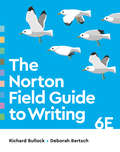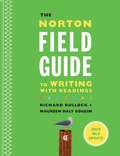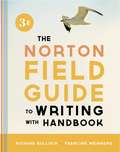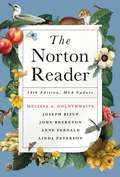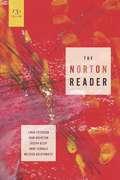- Table View
- List View
The Norton Field Guide to Writing
by Richard H. BullockThe best-selling, most flexible rhetoric―now with advice for reading and writing across disciplines. <p><p> The Norton Field Guide lets you teach the way you want to teach. Short chapters with just enough detail can be assigned in any order. Color-coded links send students to more detail if they need it. Menus, directories, and a glossary/index all make the book easy to navigate. This flexibility makes it work for first-year writing, stretch, ALP, co-req, dual-enrollment, and integrated reading-writing courses. <P><p> The Norton Field Guide MLA and APA Update Edition features the latest documentation guidelines from the ninth edition of the MLA Handbook (2021) and the seventh edition of the Publication Manual of the American Psychological Association (2020).
The Norton Field Guide to Writing (Sixth Edition)
by Richard Bullock Francine Weinberg Maureen Daly Goggin Deborah BertschThe most flexible rhetoric for a first-year writing course—and every writing student. The Norton Field Guide lets instructors teach the way they want to teach, and helps students write in the way that works best for them. In the Sixth Edition, new coauthor Deborah Bertsch shows students how to adapt their writing to new rhetorical situations with three new chapters—Remixes, Explorations, and Reflecting on Your Writing. More inclusive than ever, the new edition features thirty new readings, including seventeen written by students, that offer fresh and inspiring sources for writing. New videos and interactive activities in InQuizitive for Writers reveal multiple ways to understand and apply the book’s advice, and are complemented by new instructor resources that respond to today’s teaching challenges. This purchase offers access to the digital ebook only.
The Norton Field Guide to Writing with Handbook (Sixth Edition)
by Richard Bullock Francine Weinberg Maureen Daly Goggin Deborah BertschThe most flexible rhetoric for a first-year writing course—and every writing student. The Norton Field Guide lets instructors teach the way they want to teach, and helps students write in the way that works best for them. In the Sixth Edition, new coauthor Deborah Bertsch shows students how to adapt their writing to new rhetorical situations with three new chapters—Remixes, Explorations, and Reflecting on Your Writing. More inclusive than ever, the new edition features thirty new readings, including seventeen written by students, that offer fresh and inspiring sources for writing. New videos and interactive activities in InQuizitive for Writers reveal multiple ways to understand and apply the book’s advice, and are complemented by new instructor resources that respond to today’s teaching challenges.
The Norton Field Guide to Writing with Readings
by Maureen Daly Goggin Richard H. BullockThe best-selling, most flexible rhetoric―now with advice for reading and writing across disciplines <P><P> The Norton Field Guide lets you teach the way you want to teach. Short chapters with just enough detail can be assigned in any order. Color-coded links send students to more detail if they need it. Menus, directories, and a glossary/index all make the book easy to navigate. This flexibility makes it work for first-year writing, stretch, ALP, co-req, dual-enrollment, and integrated reading-writing courses.
The Norton Field Guide to Writing with Readings (Fourth Edition, 2016 MLA Update)
by Richard Bullock Maureen Daly GogginFlexible, easy to use, just enough detail—and the number-one best selling rhetoric.The Norton Field Guide to Writing’s flexibility and ease of use have made it the leading rhetoric text on the market—and a perfect choice for committees representing varying teaching styles. With just enough detail — and color-coded links that send students to more detail if they need it — this is the rhetoric that tells students what they need to know but resists the temptation to tell them everything there is to know. The Fourth Edition includes new chapters on summarizing and responding, on developing academic habits of mind, and on writing literary analysis.The Norton Field Guide to Writing is also available with a handbook, an anthology, or both. To make the book more helpful for multilingual writers, the versions with the handbook include new chapters on idioms, prepositions, and Englishes; to accommodate instructors and programs teaching literary analysis, the versions with the anthology include two student essays that analyze literature and five short stories and poems for analysis.
The Norton Field Guide to Writing with Readings (Sixth Edition)
by Richard Bullock Francine Weinberg Maureen Daly Goggin Deborah BertschThe most flexible rhetoric for a first-year writing course—and every writing student. The Norton Field Guide lets instructors teach the way they want to teach, and helps students write in the way that works best for them. In the Sixth Edition, new coauthor Deborah Bertsch shows students how to adapt their writing to new rhetorical situations with three new chapters—Remixes, Explorations, and Reflecting on Your Writing. More inclusive than ever, the new edition features thirty new readings, including seventeen written by students, that offer fresh and inspiring sources for writing. New videos and interactive activities in InQuizitive for Writers reveal multiple ways to understand and apply the book’s advice, and are complemented by new instructor resources that respond to today’s teaching challenges. This purchase offers access to the digital ebook only.
The Norton Field Guide to Writing with Readings and Handbook (Sixth Edition)
by Richard Bullock Francine Weinberg Maureen Daly Goggin Deborah BertschThe most flexible rhetoric for a first-year writing course—and every writing student. The Norton Field Guide lets instructors teach the way they want to teach, and helps students write in the way that works best for them. In the Sixth Edition, new coauthor Deborah Bertsch shows students how to adapt their writing to new rhetorical situations with three new chapters—Remixes, Explorations, and Reflecting on Your Writing. More inclusive than ever, the new edition features thirty new readings, including seventeen written by students, that offer fresh and inspiring sources for writing. New videos and interactive activities in InQuizitive for Writers reveal multiple ways to understand and apply the book’s advice, and are complemented by new instructor resources that respond to today’s teaching challenges.
The Norton Field Guide to Writing with Readings and Handbook (Sixth High School Edition)
by Richard Bullock Francine Weinberg Maureen Daly Goggin Deborah BertschThe most flexible rhetoric for every high school writing student The Norton Field Guide lets instructors teach the way they want to teach and helps students write in the way that works best for them. In the Sixth Edition, new coauthor Deborah Bertsch shows students how to adapt their writing to new rhetorical situations with three new chapters—Remixes, Explorations, and Reflecting on Your Writing. More inclusive than ever, the new edition features 29 new readings, including 16 written by students, that offer fresh and inspiring sources for writing. New videos and InQuizitive for Writers reveal multiple ways to understand and apply the book’s advice and are complemented by new instructor resources that respond to today’s teaching challenges.
The Norton Field Guide to Writing, with Handbook (Third Edition)
by Richard Bullock Francine WeinbergFlexible, easy to use, just enough detail-and now the number-one best seller. With just enough detail - and color-coded links that send students to more detail if they need it - this is the rhetoric that tells students what they need to know and resists the temptation to tell them everything there is to know. Designed for easy reference - with menus, directories, and a combined glossary/index. The Third Edition has new chapters on academic writing, choosing genres, writing online, and choosing media, as well as new attention to multimodal writing. The Norton Field Guide to Writing is available with a handbook, an anthology, or both - and all versions are now available as low-cost ebooks.
The Norton Field Guide to Writing: With Readings and Handbook
by Richard Bullock Francine Weinberg Maureen Daly Goggin<P>The Norton Field Guide to Writing began as an attempt to offer the kind of writing guides found in the best rhetorics in a format as user-friendly as the best handbooks, and on top of that, to be as brief as could be. <P>We wanted to create a handy guide to help college students with all their written work.
The Norton Field Guide to Writing: With Readings and Handbook
by Richard Bullock Francine Weinberg Maureen GogginThe Norton Field Guide lets you teach the way you want to teach. Short chapters with just enough detail can be assigned in any order. Color-coded links send students to more detail if they need it. Menus, directories, and a glossary/index all make the book easy to navigate. This flexibility makes it work for first-year writing, stretch, ALP, co-req, dual-enrollment, and integrated reading-writing courses.
The Norton Field Guide to Writing: with Handbook, MLA 2021 and APA 2020 Update Edition
by Francine Weinberg Maureen Daly Goggin Richard Harvey BullockThe Norton Field Guide lets you teach the way you want to teach. Short chapters with just enough detail can be assigned in any order. Color-coded links send students to more detail if they need it. Menus, directories, and a glossary/index all make the book easy to navigate. This flexibility makes it work for first-year writing, stretch, ALP, co-req, dual-enrollment, and integrated reading-writing courses. <p><p> The Norton Field Guide MLA and APA Update Edition features the latest documentation guidelines from the ninth edition of the MLA Handbook (2021) and the seventh edition of the Publication Manual of the American Psychological Association (2020).
The Norton Field Guide to Writing: with Readings and Handbook (Seventh High School Edition)
by Richard Bullock Maureen Daly Goggin Deborah BertschThe best-selling rhetoric that is as flexible as writing and teaching is today—especially in the DE classroom. More widely assigned than any other rhetoric, The Norton Field Guide to Writing prioritizes flexibility and choice for both students and instructors. It supports a variety of teaching contexts and approaches—from genres to rhetorical strategies, advanced composition to dual enrolled, one semester to two. Its user-friendly design makes it easy to navigate in any format, with short chapters, unique cross references to more detail, annotated examples, and embedded videos in the ebook. The Seventh Edition offers even more ways to inspire student agency with new advice that explores generative AI and learning online; new prompts that foster remix and transfer of writing to varied situations; new readings that provide refreshed models; and an expansion of the resources that teachers most loved in previous editions. This purchase offers access to the digital ebook only.
The Norton Guide to AP® Literature (AP® Edition): Writing And Skills
by Melissa Smith Susan BarberThe guidance every AP® Literature student needs The Norton Guide to AP® Literature, written by master teachers, provides all the instruction that students need to succeed in the course. The book unpacks and demystifies the skills central to the course, and offers four chapters on writing that walk students through the process of close reading and illustrate strategies for effective writing. Targeted, scaffolded lessons and two full practice AP® exams at the end of the book will make all AP® Literature students confident in their ability to succeed in the class and on the exam. This purchase offers access to the digital ebook only.
The Norton Introduction To Literature With 2016 MLA Update
by Kelly MaysThe Norton Introduction to Literature presents an engaging, balanced selection of literature to suit any course. Offering a thorough treatment of historical and critical context, the most comprehensive media package available, and a rich suite of tools to encourage close reading and thoughtful writing, the Twelfth Edition is unparalleled in its guidance of understanding, analyzing, and writing about literature.
The Norton Introduction To Literature: 2016 MLA Update (Twelfth Shorter Edition)
by Kelly J. MaysThe Norton Introduction to Literature presents an engaging, balanced selection of literature to suit any course. <P><P>Offering a thorough treatment of historical and critical context, the most comprehensive media package available, and a rich suite of tools to encourage close reading and thoughtful writing, the Shorter Twelfth Edition is unparalleled in its guidance of understanding, analyzing, and writing about literature.
The Norton Introduction to Literature
by Kelly J. MaysThis diverse and affordable collection offers the trusted writing guidance students need, along with the exciting mix of stories, poems, and plays instructors want. The Thirteenth Edition adds more contemporary works to engage today's students and new pedagogical tools to help foster close reading and careful writing, making this book the best choice for helping students appreciate, analyze, and write.
The Norton Introduction to Literature (Fifteenth Edition)
by Kelly J. MaysHelp all students become close readers and confident writers. The Norton Introduction to Literature helps all students become close readers and confident writers because it offers trusted writing and reading guidance they need, along with the exciting mix of stories, poems, and plays instructors want. Newly added works by today’s most vibrant and diverse writers will show students the power and relevance of literature. Adaptable to many different teaching approaches and styles, this new edition has been revised to provide a book and resource package that is as engaging, inclusive, and flexible as possible. This purchase offers access to a standalone third-party ebook that is not delivered by Norton. To receive the full learning experience on Norton’s platform for a similar or lower cost, including all available learning tools and an engaging, user-friendly layout, please explore the Norton-delivered courseware purchase option for this title.
The Norton Introduction to Literature (Shorter Fourteenth Edition)
by Kelly J. MaysHelp all students become close readers and confident writers The Norton Introduction to Literature?offers the trusted writing and reading guidance students need, along with an exciting mix of the stories, poems, and plays instructors want. The Shorter Fourteenth Edition is the most inclusive ever, with more contemporary and timely works sure to engage today’s students. New media-rich pedagogical tools further foster close reading and careful writing, making this book the best choice for helping all students understand, analyze, and write about literature.
The Norton Reader (Fourteenth Edition, MLA Update)
by Joseph Bizup Melissa Goldthwaite John Brereton Anne Fernald Linda PetersonThe Norton Reader began as an attempt to introduce students to the essay as a genre, and to create an anthology of excellent nonfiction writing. This new edition continues that tradition, offering a wide selection of essays on a broad range of subjects, and including examples of the kinds of writing students are most assigned, from profiles and arguments to narratives and analyses.
The Norton Reader: An Anthology of Nonfiction (13th Edition)
by Linda H. Peterson John C. Brereton Joseph Bizup Anne E. Fernald Melissa A. GoldthwaiteThe Norton Reader began as an attempt to introduce students to the essay as a genre, and to create an anthology of excellent nonfiction writing. This new edition offers a wide selection of essays on a broad range of subjects--from Jhumpa Lahiri recalling the town in Rhode Island where she grew up to Peter Singer contemplating how much billionaires should give, to Rita Dove meditating on her religious heritage.
The Norton Reader: An Anthology of Nonfiction (Shorter 11th edition)
by Linda H. Peterson John C. BreretonSince the first edition in 1965, The Norton Reader has upheld a tradition of anthologizing excellent prose.
The Norton Reader: An Anthology of Nonfiction (Shorter 12th edition)
by Linda H. Peterson John C. BreretonWith readings in a wide variety of genres, subjects, and styles, it offers the largest and most thoughtfully chosen collection of essays for composition students today. The Twelfth Edition has been carefully revised, with 25 percent of its readings new and an extensive new introduction to reading and writing with guidelines to all the elements cited in the WPA Outcomes Statement. Available in two editions: a full edition, with 206 readings; and a shorter edition, with 123.
The Norton Reader: An Anthology of Nonfiction Prose 11th Edition
by Linda H. Peterson John C. BreretonAvailable in this Shorter Edition, with fourteen thematic chapters, The Norton Reader has been carefully designed to support a wide range of teaching styles and situations.
The Norton Sampler
by Thomas CooleyWith 71 readings (half new to this edition), well-written writing instruction (including templates to help students get started), and new navigation features that make it very easy to use, The Norton Sampler is a rhetorically arranged reader that practices what it preaches about good writing.

